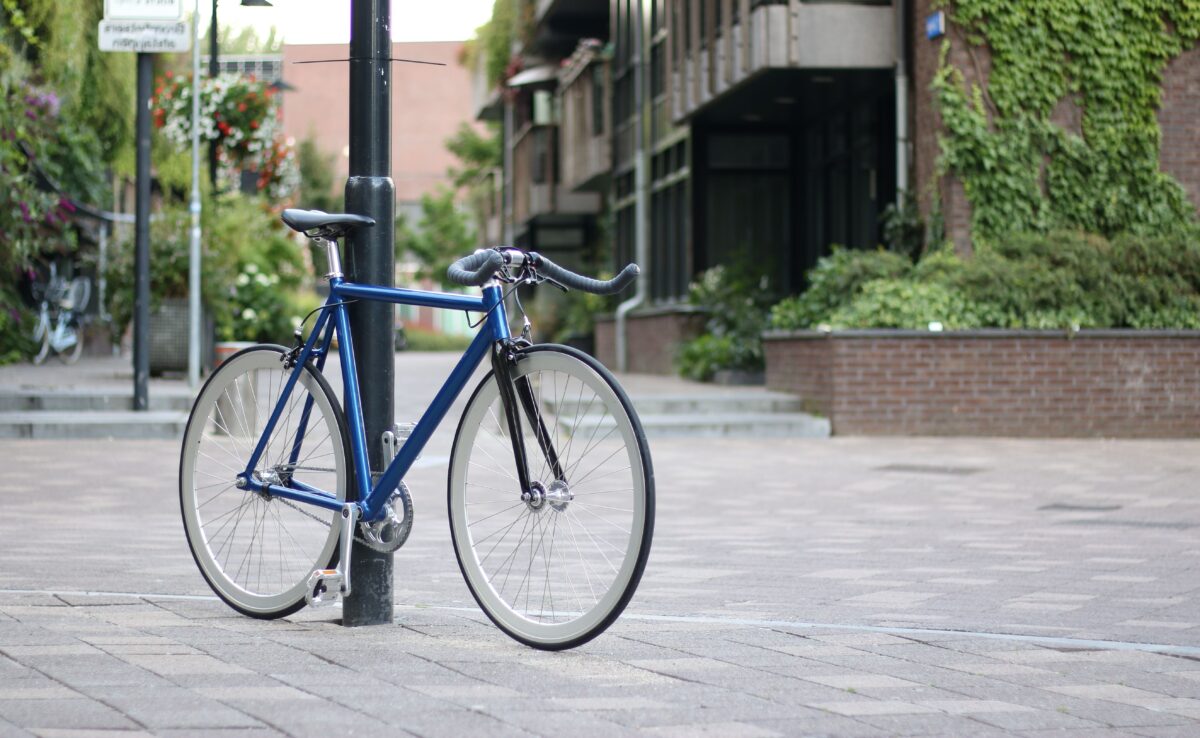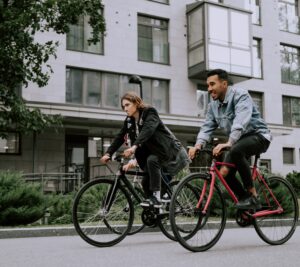When people buy newly fixed gear bikes they have tons of questions but very few answers on the internet.
Questions that I will cover in this post are different and not a lot of answers are available on the internet, but some people still might wonder every now and then, today I will be answering those questions to fill the gap of content.
Buying a new bike comes with a lot of questions this post covers the questions from a different angle, in the simplest form.
As a fixed-gear rider, there are some questions I thought to myself while I was looking to upgrade my bike by adding a couple of items or removing them, to make it faster and to have more fun with fixed gear.
Table of Contents
Can you add disc brakes on your fixed gear bike?
Fixed gear bikes generally don’t have brakes, because it is a fixed gear cog that is attached to the back wheel of the bike means you should keep on pedaling if you stop pedaling bike will force the back wheel to skid stop.
Adding a disc front brake on a fixed gear is a new thing, typically fixed-gear riders don’t prefer any brakes even though it is illegal in some parts of the country. Adding back brakes to fixed gear is useless because it will automatically stop the bike if the rider stops pedaling.
Disc brakes on the front wheel of fixed gear are not common but if you still considering adding discs to your fixie make sure the rim and forks are strong enough to hold the pressure of the disc when you pull the brakes.
Fixed gear rims are generally not built to hold discs on the front of fixed gear so try to add gravel rim because gravel rims are built to hold disc brakes.
You can always add rim brakes to your fixed gear (front wheel) it is far cheaper and more reliable than discs brakes for fixed gear bikes.
Mechanical brakes are best suitable for fixed gear bikes because fixies already come with a unique and effective way of stopping the bike, adding hydraulic brakes to fixed gear makes no sense and it also won’t fit for all the rims so the mechanical brake is good to go with fixed gear.
Can you turn your fixie into a freewheel?
Turning fixed gear into freewheel is easy to work, to do that first you should buy a flip hub back wheel which comes with fixed gear on the one side and freewheel on the other, whenever you want to change fixie into freewheel you can just remove the back wheel and put it back on from other side, and there you go now your bike has turned fixie to freewheel bike.
When you turn your fixed gear bike into a freewheel bike you want to install brakes on the bike since you can’t stop the bike like fixed gear bikes, having brakes will definitely help you while riding a freewheel.
If you don’t have a flip hub rear-wheel or you just have a typical wheel with a fixed gear cog attached to the wheel, then you should first remove your back wheel and then install a freewheel cog. When the bike is turned into a freewheel make sure to run the brakes.
To turn fixie into freewheel you need some tools like a chain whip, locker tool, chain breaker, with these tools you can swap them yourself.
Perfect gear ratio for fixie bike?
Perfect gear ratio for your fixed gear depends on you, your strength, the terrain you ride, how much weight you carry, whether you are riding with brakes or brakeless, or you like to spin or mash the list goes on, it’s not about just choosing the right gear.
The bike gear calculator shows you the different gear ratios with your best suitable situation.
50 to 70 gearings
It will help you to climb steep hills, but it might be spinning on the flat roads (since its low gearing) this gear is also good if you are carrying weight, you can pedal without much pressure on your knees, 50 to 70 gearing start with 42 tooth on crankset and 18 or more on the cog.
75 to 85 gearings
majority of fixed bike riders use this gear ratio, some fixed-gear bikes come with 75 to 85 because it’s the friendly gear for everybody if you live in a city with 50% climbing and 50% flat roads riding this gear will be perfect for you.
the higher gear will give you some room to go faster and your pedals won’t spin out on decent since it has a higher gear ratio.
90 to 120 gearings
90 to 120 considered has higher gear ratio, it is only used for racing and to break world records on tracks, using gear of 90 or more gearing can cause knee problem and it is not recommended to ride on the streets.
Higher gear ration is much harder to stop and forget about climbing hills with this gear, and the speed of the gear is not controllable in city-type roads.
The only way to find out which one works best for you is to try different gear ratios on all the terrains, you can definitely feel the differences while pedaling, and chose the one that works well for you.
Why do fixie bikes have no brakes?
The name itself says, fixed gear means cog is connected to the back of the bike when you pedal it will go forward, if you pedal backward the bike will go backward.
Fixed gear was invented to ride on velodromes while riding on a track having brakes on the bike can cause an accident, racers at velodromes can go at the speed of 60 km per hour.
Now imagine if a person in the front applies brakes then there will be a huge crash and a lot of racers might get serious injuries on the track.
Coming to riding fixed gear on streets installing brakes on your bike is definitely a safe option in the streets, you can’t predict the situation, when you have brakes you can manage to stop the bike safely.
Do fixies need brakes?
It depends on you and the city you are living in, what I mean by that is you can ride a fixed-gear bike with brakes and without brakes too, but always check your state for laws because in some states or countries it is illegal to ride without brakes on fixies.
You can have great fun riding a fixed gear by having brakes you will have more control over your bike to stop suddenly and without having brakes means you have to stop the bike by rear wheel skid which takes some practice to successfully stop it.
If you are living in a city with decent, uphill riding and a lot of pedestrians then it is a good choice to install brakes on your fixed gear bike.
Perfect chain tension for Fixed gear bike
While riding fixed gear it is important to have proper chain tension, you don’t want the chain to fall off while riding on the descent, if you don’t have brakes attached there is no other way to stop the bike, it is so important to have the perfect chain tension especially if you riding without brakes on your fixie.
To have proper chain tension:
First step: Loosen both side nuts of the back wheel, now the chain should be is loose enough
Second step: Now push the front of the back wheel a little to the left, this makes the axel slide forward in dropouts, if you push the back wheel to the right the axel will slide backward.
Third step: when you push your back wheel to right or left it makes the chain tight, now tighten both nuts of the back wheel
Fourth step: now your back might not be in a proper alignment if your back wheel is turned on the left or right side lose both nuts keep it in the middle and tighten up both nuts.
After you have done four steps now your chain should be tight enough, make sure to tighten the nuts and axel in the dropout to have a perfect chain tension.
A quick tip: if you put too much grease on your chain it will fall off eventually so remember (little is more)
How often should I lubricate my fixed gear bike?
It is important to lubricate your bike once a month, or for every 200 to 300 km to keep your chain clean and to avoid rust.
Lubricating your bike chain gives better performance and a smooth noiseless riding experience, if you put too much lube on the chain it might fall off while riding, for a fixed gear bike, the chain is the main part that helps you to stop your bike unless you are using brakes.
How to properly lubricate your bike
- Clean the chain with a dry cloth (cotton cloth recommended)
- Now apply lube while rotating the crankset gently
- Keep applying till the whole chain is lubed it takes about 7 to 10 seconds
Can you pedal a fixie bike backward?
Yes, you can pedal backward in fixed gear but it’s not safe, pedaling backward is more of a stunt than a necessary thing to do if you want to ride fixed gear backward first try riding on an open space like a parking lot open field.
How often should I replace the back wheel of a fixie bike?
This is an underrated question, when it comes to a fixed-gear bike, how often you should replace your back wheel on fixed depends on all the other factors like how much you weigh, how much you carry weight, how aggressively you ride, and how often do you apply brakes
If you ride with brakes on your bike the tire should last around 1500 to 3000 miles (2415 to 4828 km)
If you are riding without brakes on fixed gear meaning you are stopping your bike by back wheel skid stop by putting pressure on pedals
In this way, stopping can decrease your back tire durability faster.
Riding without brakes on a fixed gear, you need to replace tires after 1000 to 2000 miles (1600 to 3200 km)
Again it depends on terrain, your body weight, bike weight you are riding on, these factors define the lifespan of your back wheel of fixed gear.
Are fixie bikes hard to ride for beginners?
As a beginner learning to ride a bycycle is pretty easy with someone’s help any child or grown man can learn how to ride a bike with a couple of weeks of practice.
I would not suggest a fixed gear bike for beginners, first have some experience riding single speed or even shifter, once you build brain memory of how things work then you can maybe switch up to fixed gear bikes but definitely not at the beginning for a new cyclist.
click here to read detailed article on beginners guide for fixed gear bikes
For anyone who’s learning to ride a bike, in the beginning, the most commonly used bike is a single-speed bike because it allows you to freestyle meaning you don’t have to pedal all the time and the bike will still be going forward.
Beginner level cyclists might find it hard to ride fixed gear bikes because you have to get used to pedaling always even if is downhill or uphill there is no option for the freewheel.
Conclusion
The question above answers some of the most underrated questions about fixed gear bikes and as a fixie owner it is important to know answers about these questions it might come in handy when you need them most.
Now you know the answer to most unanswered questions on the internet, save this post to look back when you need an answer to any of the questions above.






